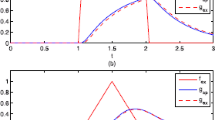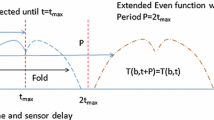Abstract
The problem of determining the temperature at one end of a rod by means of interior temperature measurements has considerable practical importance and has been well studied, however, few exact solutions have been found. Most of the applicable results therefore, have been obtained from the (numerical) analysis of discretized systems. In this paper we present an analytic method for obtaining solutions to this problem which does not require differentiation (only integration) of the interior temperature readings and is valid for general finite energy boundary data and for general radiation boundary conditions at the known end of the rod.
Similar content being viewed by others
References
J. V. Beck, B. Blackwell, C. R. St. Clair, Jr.,Inverse Heat Conduction, Ill-posed Problems, Wiley, New York, 1985.
O. R. Burggraf, An exact solution of the inverse problem in heat conduction theory and applications,ASME Journal of Heat Transfer, Vol. 86c, 1964, pp. 824–831.
J. R. Cannon,The One-Dimensional Heat Equation, Encyclopedia of Mathematics and Its Applications, Vol. 23, Addison-Wesley, Reading, MA, 1984.
J. L. Doob,Classical Potential Theory and Its Probabilistic Counterpart, SpringerVerlag, Berlin, 1983.
A. Friedman,Partial Differential Equations of Parabolic Type, Prentice-Hall, Englewood Cliffs, NJ, 1964.
D. S. Gilliam, J. R. Lund, and C. F. Martin, Analytic and numerical aspects of the observation of the heat equation, Preprint Texas Tech University.
D. S. Gilliam, B. A. Mair, and C. F. Martin, Observability and determination of surface temperature, I, Preprint Texas Tech University.
D. S. Gilliam, C. Martin, and Zhu Li, Discrete observability for the heat equation in bounded domains, to appear inInternational Journal of Control.
D. S. Gilliam and C. Martin, Discrete observability and Dirichlet series, to appear inSystems and Control Letters.
I. S. Gradshteyn and M. Ryzhik,Tables of Integrals, Series, and Products, Academic Press, New York, 1980.
M. Imber and J. Kahn, Prediction of transient temperature distributions with embedded thermocouples,AIAA Journal, Vol. 10, No. 6, 1976, pp. 723–727.
M. M. Lavrent'ev, V. G. Romanov, and S. P. Shishatskii,Ill posed Problems of Mathematical Physics and Analysis, Translations of Mathematical Monographs, Vol. 64, American Mathematical Society, Providence, RI, 1986.
Y. Sakawa, Observability and related problems for partial differential equations of parabolic type,SIAM Journal of Control, Vol. 12, No. 1, 1975, pp. 389–400.
E. M. Sparrow, A. Haji-sheikh, and T. S. Lundgren, The inverse problem in transient heat conduction,Journal of Applied Mechanics, Vol. 31, 1964, pp. 369–375.
E. C. Titchmarsh,Theory of Functions, Clarendon Press, Oxford, 1932.
K. Yosida,Functional Analysis, Springer-Verlag, New York, 1968.
D. V. Widder,The Heat Equation, Academic Press, New York, 1975.
Author information
Authors and Affiliations
Rights and permissions
About this article
Cite this article
Gilliam, D.S., Mair, B.A. & Martin, C.F. A convolution method for inverse heat conduction problems. Math. Systems Theory 21, 49–60 (1988). https://doi.org/10.1007/BF02088005
Received:
Revised:
Issue Date:
DOI: https://doi.org/10.1007/BF02088005




